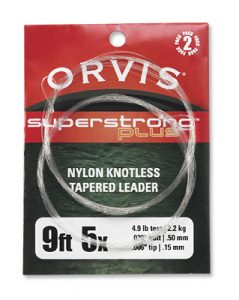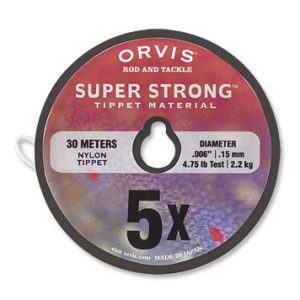It’s nearly impossible to talk about leaders without talking about tippet, and vice versa. However, we could go into an enormous amount of detail on either of them – so much so that it would defeat the intended purpose of a brief monthly article that attempts to provide a simple definition of how particular pieces of fly fishing gear “work.” So, consider this a broad introduction of how the two things work together as part of the overall fly fishing “system.” We’ll talk about each individually in more detail in future articles.

The leader is the monofilament (usually) connection between the weighted fly line and the fly. Most commonly 7’ to 12’ in length, the leader is typically tapered and consists of three parts: the butt, the taper, and the tippet. These parts are completely separate and easily distinguished in formulated leaders created by knotting different diameters of monofilament together. However, most commercially produced leaders are created with an acid process that results in a knotless, seamless taper from top to bottom.
In either case, the butt is the thickest section that attaches to the fly line. Its purpose is to “turn the leader over” with the cast. A leader with no butt, or too thin of a butt, has a tendency to collapse rather than extend and straighten. The tippet is the thinnest part of the leader that attaches to the fly. It allows the energy of the cast to dissipate. As a result, you’re less likely to crash the cast on the water. The tippet also allows for a less visible connection to the fly. The taper is the section between the butt and tippet that provides a smooth, progressive transfer of energy. A leader with a thick butt tied directly to thin tippet tends to “hinge.”
They size leaders by their length and tippet size. So, if you purchase a 9’ 5x leader, it has a tippet size of 5X and its overall length is 9’. As a general rule, longer leaders are advantageous for not only creating more distance between fly line and fly, but for achieving better drifts in “technical” currents. However, they are more difficult to cast and more prone to find overhanging limbs! A shorter leader can allow for more accuracy in tighter areas.
They size tippet by its diameter and indicate the size with a number followed by an “x.” The bigger the number, the smaller the tippet. So a 6X tippet is considerably smaller than a 2X tippet. Without getting too deep into the history of what now seems a rather antiquated system, it all works off the number 11. The tippet size subtracted from 11 equals the actual diameter measured in thousandths of an inch. For instance, 6X tippet is .005”. It works in reverse too. If the actual diameter of the monofilament is .007”, the tippet size is 4X: 11-7=4. Pretty weird, huh?

You don’t need to know all of that, though. Just remember that you usually choose tippet size based on the fly size. Small flies should have small tippets and big flies should have big tippets. Some leader packages will have cross-reference charts on the back indicating which tippet sizes match which fly sizes. Another neat trick is to divide the fly size by 3. So a size #12 fly would best match a size 4X tippet. Could you use a 5X tippet on a #12 fly? Absolutely. This is just a guideline. But the farther you stray from the guideline the more problems you’ll encounter.
So, tippet is part of the leader. But tippet is also purchased by itself on spools. Tippet material is pulled from the spool and spliced to the leader with a knot to rebuild or alter the leader. For instance, if you start the day with a 9’ 5X leader and you change flies a few times or break off in a tree, your tippet gets shorter and shorter. You can add tippet from a spool when this happens to build the leader back to its original size.

